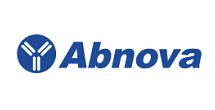APOA1 & FGA Protein Protein Interaction Antibody Pair



* The price is valid only in USA. Please select country.
-
More Files
- More Functions
-
Specification
Product Description
This protein protein interaction antibody pair set comes with two antibodies to detect the protein-protein interaction, one against the APOA1 protein, and the other against the FGA protein for use in in situ Proximity Ligation Assay. See Publication Reference below.

Reactivity
Human
Quality Control Testing
Protein protein interaction immunofluorescence result.
Representative image of Proximity Ligation Assay of protein-protein interactions between APOA1 and FGA. HeLa cells were stained with anti-APOA1 rabbit purified polyclonal antibody 1:1200 and anti-FGA mouse monoclonal antibody 1:50. Each red dot represents the detection of protein-protein interaction complex. The images were analyzed using an optimized freeware (BlobFinder) download from The Centre for Image Analysis at Uppsala University.
Supplied Product
Antibody pair set content:
1. APOA1 rabbit purified polyclonal antibody (100 ug)
2. FGA mouse monoclonal antibody (40 ug)
*Reagents are sufficient for at least 30-50 assays using recommended protocols.Storage Instruction
Store reagents of the antibody pair set at -20°C or lower. Please aliquot to avoid repeated freeze thaw cycle. Reagents should be returned to -20°C storage immediately after use.
-
Applications
In situ Proximity Ligation Assay (Cell)
-
Gene Info — APOA1
Entrez GeneID
335Gene Name
APOA1
Gene Alias
MGC117399
Gene Description
apolipoprotein A-I
Gene Ontology
HyperlinkGene Summary
This gene encodes apolipoprotein A-I, which is the major protein component of high density lipoprotein (HDL) in plasma. The protein promotes cholesterol efflux from tissues to the liver for excretion, and it is a cofactor for lecithin cholesterolacyltransferase (LCAT) which is responsible for the formation of most plasma cholesteryl esters. This gene is closely linked with two other apolipoprotein genes on chromosome 11. Defects in this gene are associated with HDL deficiencies, including Tangier disease, and with systemic non-neuropathic amyloidosis. [provided by RefSeq
Other Designations
OTTHUMP00000069346|OTTHUMP00000069347|OTTHUMP00000069348|apolipoprotein A1
-
Gene Info — FGA
Entrez GeneID
2243Gene Name
FGA
Gene Alias
Fib2, MGC119422, MGC119423, MGC119425
Gene Description
fibrinogen alpha chain
Gene Ontology
HyperlinkGene Summary
The protein encoded by this gene is the alpha component of fibrinogen, a blood-borne glycoprotein comprised of three pairs of nonidentical polypeptide chains. Following vascular injury, fibrinogen is cleaved by thrombin to form fibrin which is the most abundant component of blood clots. In addition, various cleavage products of fibrinogen and fibrin regulate cell adhesion and spreading, display vasoconstrictor and chemotactic activities, and are mitogens for several cell types. Mutations in this gene lead to several disorders, including dysfibrinogenemia, hypofibrinogenemia, afibrinogenemia and renal amyloidosis. Alternative splicing results in two isoforms which vary in the carboxy-terminus. [provided by RefSeq
Other Designations
fibrinogen, A alpha polypeptide|fibrinogen, alpha chain, isoform alpha preproprotein|fibrinogen, alpha polypeptide
-
Interactome
-
Pathway
-
Disease
- +1-909-264-1399
+1-909-992-0619
Toll Free : +1-877-853-6098 - +1-909-992-3401
- sales@abnova.com
















